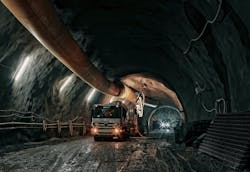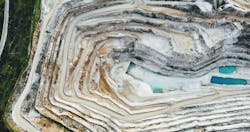6 Ways to Improve Water Conservation in Mining Operations
The mining industry is a key component of the global low-carbon transition. If world leaders want to limit global average temperature rise to 2°C, they must have more than 3.3 billion tons of minerals and metals to deploy renewable energy storage and generation. This will include wind, solar, geothermal and nuclear energy. According to a World Bank report,1 mineral production such as that of lithium, graphite and cobalt could increase by as much as 500% by 2050 to meet these needs.
But mining also happens to be on the front line of water security risk. The mining industry uses water for a variety of purposes, including mineral processing (e.g., flotation), dust suppression, slurry transport and storage, extraction processes and site usage. In most mining operations, operators extract water from groundwater, streams, rivers, lakes or through commercial water service suppliers. And to make things worse, some mining sites are in areas where water is already scarce.
As water experts warn of a serious global water shortage coinciding with climate change, sustainable water management within the mining industry will be critical.
There is already evidence of a growing awareness of the need for water sustainability within organizations in the mining industry. A 2019 Carbon Development Project (CDP) analysis2 stated 91% of respondents from the mining industry reported exposure to water-related risks. The respondents expect almost two-thirds (61%) of those risks to materialize in the next three years.
While the exact specifics and efficiencies to be gained will vary greatly depending on the technicalities of the industry process and the complexity of design and geographic location, there are a few proven tactics to optimize water management. Here are six ways to improve water conservation in the mining industry:
Wastewater Treatment and Closed-Loop Recycling
One of the most common ways to maximize the reusage of water is to install a water treatment unit. There are various efficient technologies available for wastewater treatment. The precise solution, however, will depend on each project’s treatment requirements. Some of the common solutions include membrane technology and thermal treatments for salt-based pollutants. There is also bio-reactor and polymer extraction for organic pollutant treatments.
Wastewater treatment units treat effluent and recover water for reuse and drinking water purposes. They also help minimize the environmental compliance challenges and risks associated with effluent discharges. When and if installed, the next step would be to ensure an optimized automated chemical dosage in the water/wastewater treatment process. Then operators should develop a maintenance and reliability plan to cut downtime impact.
Most mines operate some sort of recycling system to minimize the draw on fresh water. But the concept behind a “closed-loop” system is to virtually end water losses from the system. For example, Anglo American,3 a British multinational mining company, is focusing on two areas: evaporation measurement and dry tailings (waste) disposal.
Leak Management
Like any other industry, mining operations distribute water through a network of pumps, valves and pipes. And like most other industries, leaks always pose a production or economic risk to some extent.
Even if individual leaks appear small, they can often accumulate into a large volume quickly if not managed properly. The following are some of the best practices related to water leak management:
- Assess and plan for installations, considering the capacity and probability and frequency of failures. Also consider the impact of an emergency on the water requirements, both inside and outside of the mine.
- Carry out proactive equipment maintenance4 for the installations such as NDT inspection of pipes.
- Install mechanisms for the timely detection of leaks in process water. This can be something as simple as moisture elements, or more complex as IoT-based pressure and flow-monitoring sensors.
- Repair leaks expeditiously when they occur.
R&D and Innovation
Some of the world’s biggest leaps in technology have occurred in the face of crisis, where minds focused on developing innovative solutions to age-old problems. Innovation through research and development can pave the way for industry-leading water conservation technology. Of course, the exact solution will differ depending on the domain specifics within the mining industry.
One example can be found in industrial-scale experiments conducted by Helmholtz Institute Freiberg for Resource Technology (HIF)5 based in Germany. This group demonstrated how water usage can be optimized in the extraction of fluorite, an important raw material used in the smelting of iron and aluminum extraction. On a similar note, Anglo American is also exploring methods for dry separation of ore, with early estimates showing the potential for as much as 40% reduction in water used per unit of mineral production.
Data-Driven Process Optimization
Leveraging modern technology such as artificial intelligence (AI) and analytics-backed IoT sensors can work wonders for legacy plants. The pay-off period may not be immediate. Operators must collect the data first to understand the points of inefficiencies before they can take corrective actions through real-time AI-enabled systems.
AI can reduce energy in water/wastewater treatment processes to save on costs and maximize wastewater reuse. Installing an AI system at the mining site that allows plant staff to leverage historical data as well as continuously monitor and optimize the assets for water consumption. Like most AI-enabled technology, effectiveness only improves with time as it keeps learning from process parameters.
Water Management Audit
A fundamental part of any water conservation plans is a regular water management audit. This procedure allows operators to continuously evaluate opportunities for improvement. An audit involves accounting for every cubic foot of water that goes in and out of the site and analyzing improvement opportunities in each of the processes.
The next step would be industry benchmarking to compare the audit results against industry leaders and take actions to incorporate those potential improvements. The 2012 International Council of Mining & Metals (ICMM) Report6 discusses multiple case studies of companies finding significant areas of improvement following a comprehensive water audit.
Employee Training & Engagement
Educating the staff on the importance of water conservation will help them understand why continuous improvement is essential. True environmental stewardship requires that everyone in the organization believes in the operation’s water goals. And each staff member must feel comfortable in challenging existing procedures and share ideas.
Final Thoughts
The mining industry is currently faced with significant challenges not only in terms of energy usage, but water consumption as well. The World Economic Forum7 predicts a shortfall of 40% between demand and supply of water by 2030. This represents the greatest global economic risk over the next decade.
Saving water is vital for the long-term sustainability of the mining industry. Embracing new technologies and strategies is one step in the right direction.
References
- Hund, Kirsten, Daniele Porta, Thao Fabregas, Tim Laing, and John Drexhage. “CLIMATE-SMART MINING FACILITY Minerals for Climate Action: The Mineral Intensity of the Clean Energy Transition.” 2020. http://pubdocs.worldbank.org/en/961711588875536384/Minerals-for-Climate-Action-The-Mineral-Intensity-of-the-Clean-Energy-Transition.pdf.
- “IN TOO DEEP Analysis for Institutional Investors of Critical Water Security Issues Facing the Metals and Mining Sector.” CDP, 2019. https://6fefcbb86e61af1b2fc4c70d8ead6ced550b4d987d7c03fcdd1d.ssl.cf3.rackcdn.com/cms/reports/documents/000/004/613/original/CDP_Metals_and_mining_report_2019.pdf?1561049112.
- “Picture This: The Water-Less Mine.” www.angloamerican.com. Anglo American. Accessed March 31, 2021. https://www.angloamerican.com/futuresmart/stories/our-industry/technology/picture-this-the-waterless-mine#:~:text=Dry%20separation%20involves%20finding%20innovative.
- “Equipment Maintenance: Goals, Types, Program Setup” www.limblecmmms.com Bryan Christiansen. Accessed March 31, 2021. https://limblecmms.com/blog/equipment-maintenance.
- “Reducing Water Consumption in Mining: Digitization in Beneficiation Technology Is Helping to Ensure That This Precious Commodity Is Used Efficiently.” ScienceDaily. Helmholtz-Zentrum Dresden-Rossendorf, March 2019. https://www.sciencedaily.com/releases/2019/03/190328102647.htm.
- “Water Management in Mining: A Selection of Case Studies.” ICMM, May 2012. http://icmm.uat.byng.uk.net/website/publications/pdfs/water/water-management-in-mining_case-studies.
- VBE. “The Water Resources Group.” World Economic Forum, January 26, 2012. http://www3.weforum.org/docs/WEF/WRG_Background_Impact_and_Way_Forward.pdf.
About the Author: Bryan Christiansen is the founder and CEO of Limble CMMS. Limble is a modern, easy-to-use mobile CMMS software that takes the stress and chaos out of maintenance by helping managers organize, automate and streamline their maintenance operations.
About the Author
Bryan Christiansen
Bryan Christiansen is the founder and CEO of Limble CMMS. Limble is a modern, easy-to-use mobile CMMS software that takes the stress and chaos out of maintenance by helping managers organize, automate and streamline their maintenance operations.

